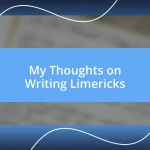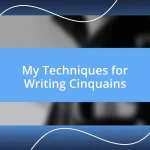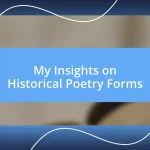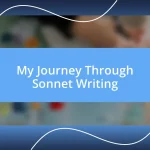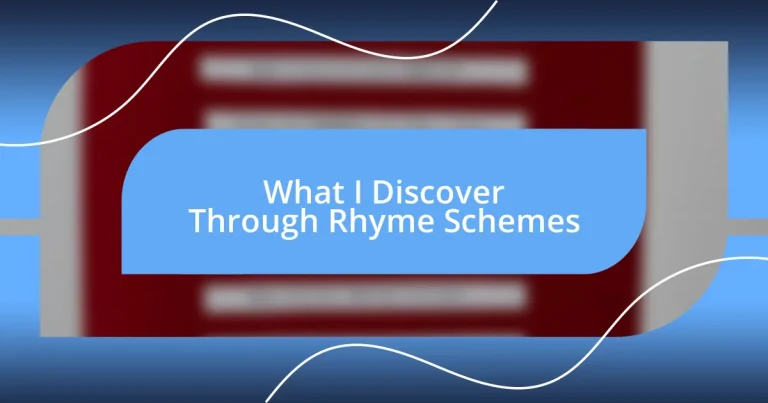Key takeaways:
- Rhyme schemes, such as ABAB or AABB, enhance the musicality, emotional depth, and memorability of poetry, allowing for creative expression.
- Experimenting with various rhyme patterns and slant rhymes can lead to innovative writing and deeper connections with readers.
- Analyzing famous poems reveals how rhyme effectively shapes narrative flow and emotional resonance, enriching the overall impact of the work.
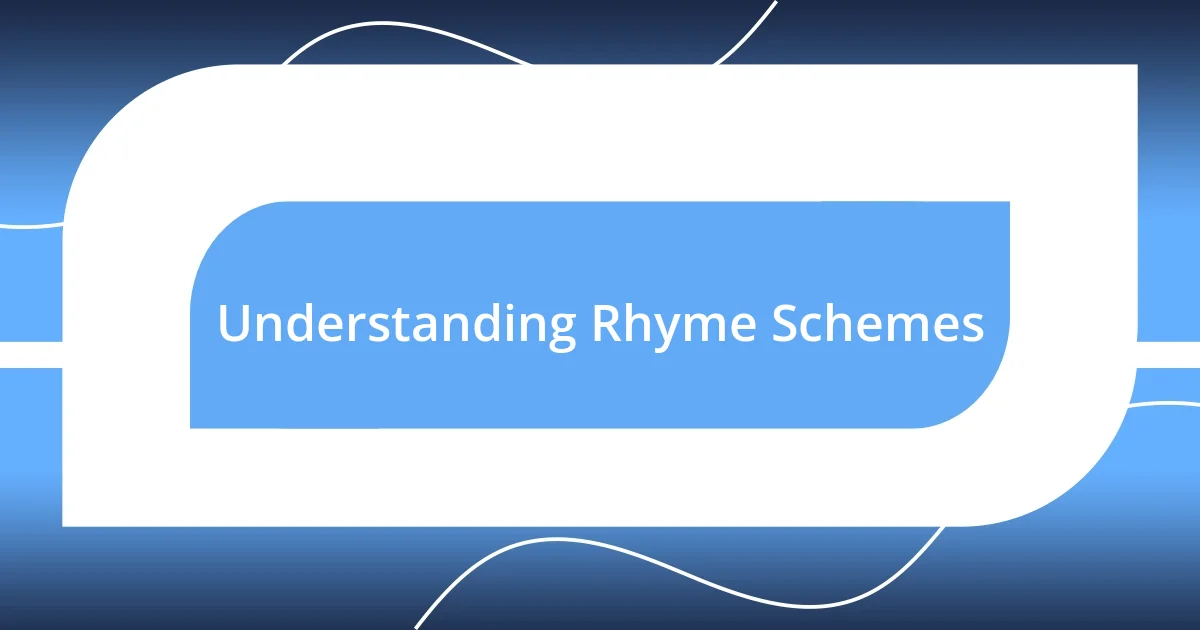
Understanding Rhyme Schemes
Rhyme schemes are the patterns of sounds that create a pleasing musicality in poetry. When I first encountered them, I found myself captivated by how a simple arrangement of words could evoke such powerful emotions. Have you ever felt the thrill of discovering a line that perfectly matched the rhythm of your thoughts?
One of the most common rhyme schemes is the ABAB pattern, where the first and third lines rhyme, as do the second and fourth. I remember writing a poem with that structure, and it was amazing to see how the alternating sounds added a dance-like quality to my verses. It’s almost like each rhyme pushes the narrative forward, compelling the reader to keep moving.
Understanding these schemes can be incredibly rewarding. They provide a framework that gives your creativity room to flourish. Have you ever tried writing a poem following an intricate rhyme scheme, like the AABB or even more complex variations? The challenge can sometimes feel daunting, yet it’s in those moments of exploration that you truly discover the depth of your own voice.
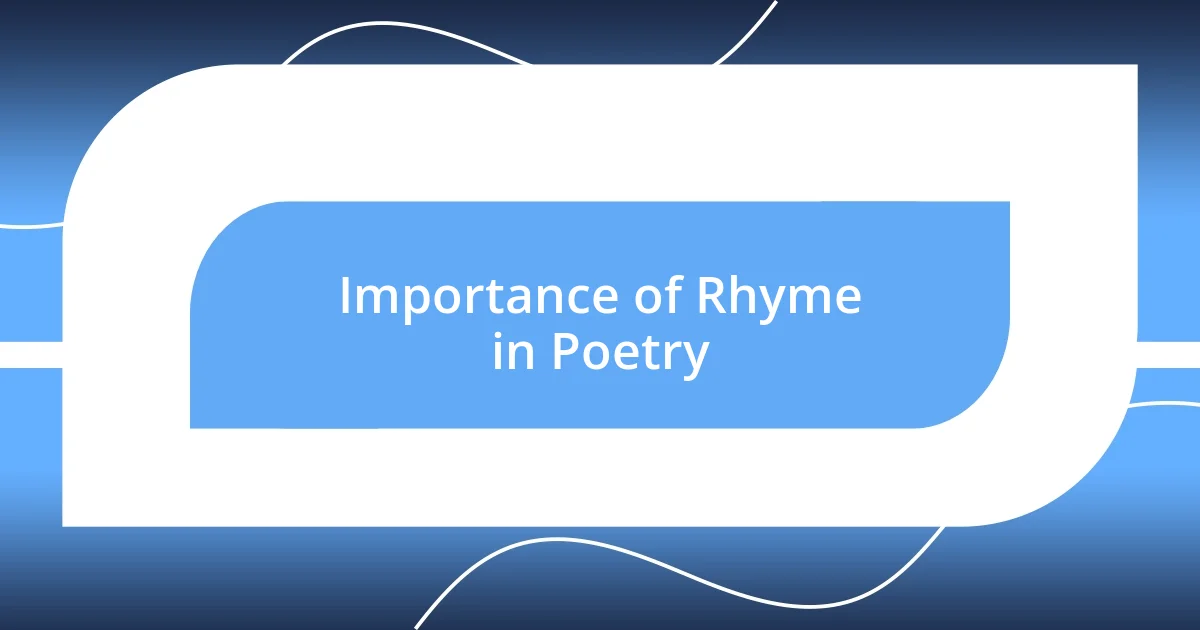
Importance of Rhyme in Poetry
Rhyme in poetry serves as a bridge between thought and emotion, often making the words resonate on a deeper level. I’ve found that when I incorporate rhyme, it transforms my writing into a rhythm that draws the reader in. For me, there’s something truly magical about hearing the echoes of sounds bounce off one another, creating connections that enhance the meaning of the poem itself.
- Creates musicality: Rhyme adds a lyrical quality that captivates both the writer and the reader.
- Enhances memorability: Rhymed poetry sticks in the mind; I still recall verses I’ve heard or written years ago because of their rhythmic patterns.
- Deepens emotional impact: When I express feelings through rhyme, it suddenly feels more poignant, as if the very sounds align with the emotions I want to convey.
- Provides structure: The constraints of rhyme can ignite creativity, pushing me to explore ideas in ways I hadn’t imagined before.
When I first dabbled in slant rhymes, the subtlety of imperfect sounds intrigued me. They allowed for a greater range of expression, yet still provided the harmony I craved. This opened a new pathway for me, encouraging a boldness in crafting verses that felt both coherent and innovative.
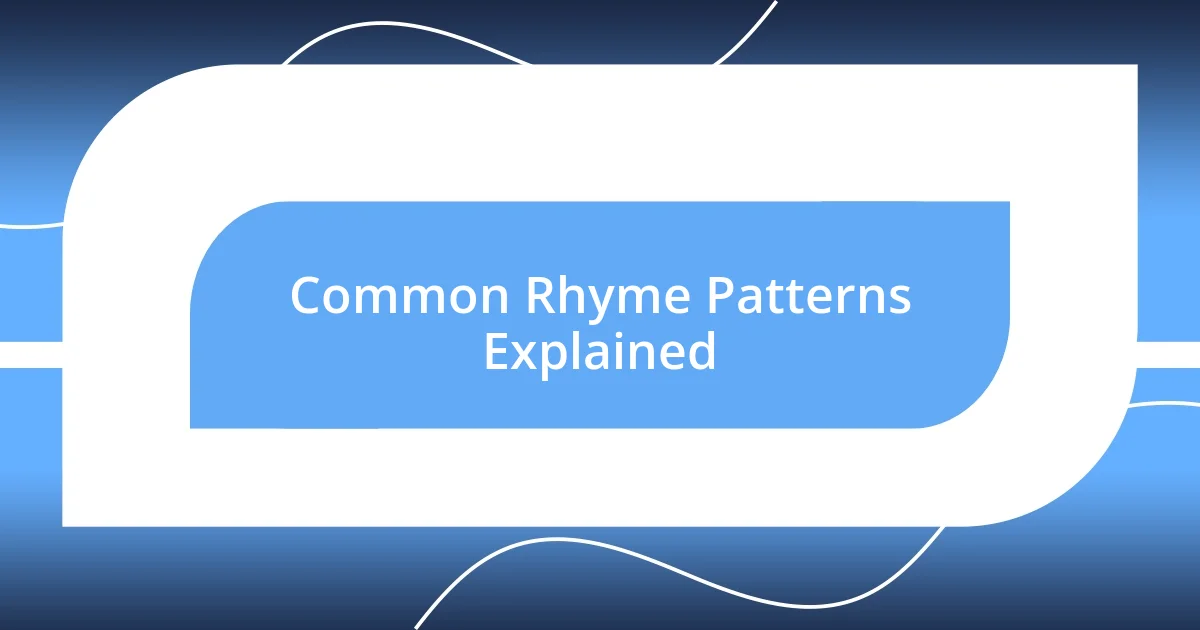
Common Rhyme Patterns Explained
One of the most intriguing aspects of poetry is its variety of rhyme patterns. For instance, the AABB scheme uses couplets where the first two lines rhyme with each other and the next two do the same. I remember my initial struggle with this format; it felt like trying to fit a square peg into a round hole. Yet, when I finally got the hang of it, the rhythm felt like a gentle embrace, wrapping around my thoughts and ideas, making them flow seamlessly on the page.
In contrast, the ABBA rhyme scheme, often referred to as “enclosed rhyme,” creates a sense of symmetry and completeness. The first and fourth lines rhyme and the second and third lines do as well, almost like a poem that folds in on itself. I find this structure particularly effective when I want to evoke a poignant moment or a deep reflection. It’s like creating a little world within a world, inviting readers to step in and explore one central idea.
Of course, there are many other rhyme patterns, such as the ABCB scheme, where the second and fourth lines rhyme, offering a less predictable yet engaging structure. This pattern often gives my poetry a conversational air, making it feel approachable and relatable. One time, I used an ABCB scheme for a piece about summer memories, which brought a light-hearted tone to my writing. It reminded me how the playfulness of rhyme can enhance the imagery and meaning we wish to convey.
| Rhyme Scheme | Description |
|---|---|
| ABAB | Alternating lines rhyme, creating a dance-like rhythm. |
| AABB | Couplet structure where pairs of lines rhyme together. |
| ABBA | Enclosed rhyme that creates symmetry and depth. |
| ABCB | The second and fourth lines rhyme, adding unpredictability. |
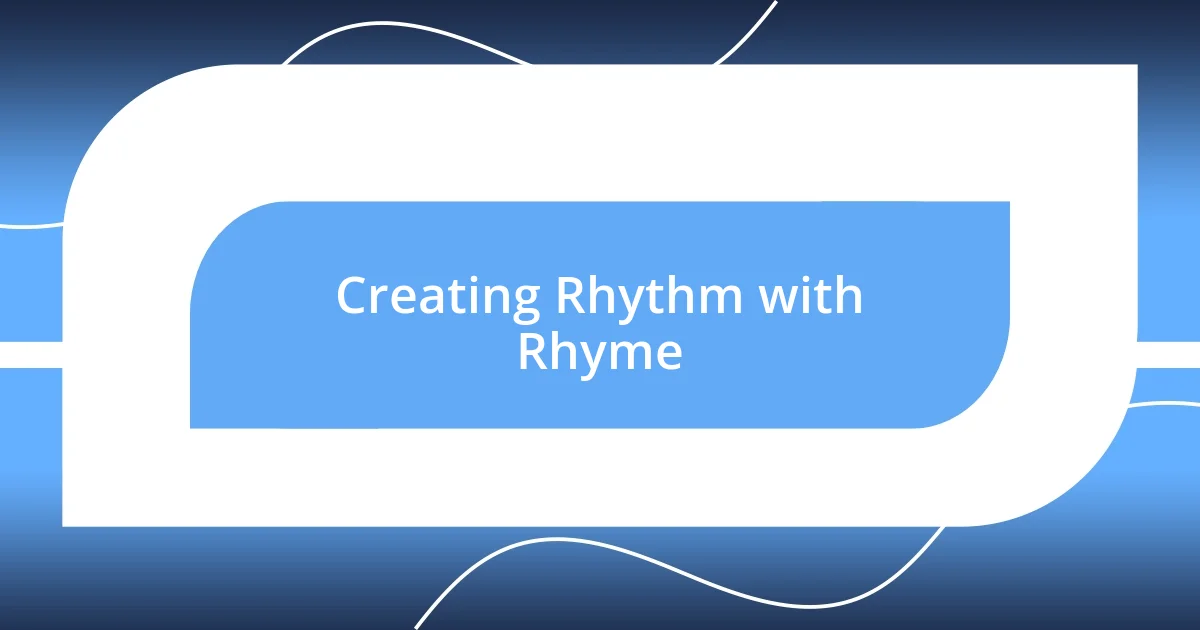
Creating Rhythm with Rhyme
Creating rhythm with rhyme is like discovering the heartbeat of a poem. I often find myself tapping my fingers to the cadence of the words as I write. When I crafted a piece about the changing seasons, the rhyme flowed effortlessly, enhancing my emotions with each couplet. Have you ever felt that rhythm resonate in your own writing?
There’s a beauty in how certain rhyme schemes can evoke specific feelings. For example, when I used an AABB pattern for a nostalgic piece about childhood, it felt like a gentle lullaby, wrapping my memories in warmth. The predictability of those pairs allowed the imagery to dance lightly on the page, making it easily relatable and instantly memorable. Doesn’t it feel satisfying when your work delivers such an emotional punch?
As I experimented with different patterns, I discovered a new layer of depth in my poetry. One particular time, I played with the ABAB scheme, which brought a vibrant game of anticipation into my lines. It was as if I was engaging readers in a playful conversation, and the energy of the piece surged with each alternating rhyme. I realized then that every rhyme scheme has its unique pulse, allowing us to create rhythms that truly resonate with our audience. What rhythm do you find yourself gravitating toward in your writing?
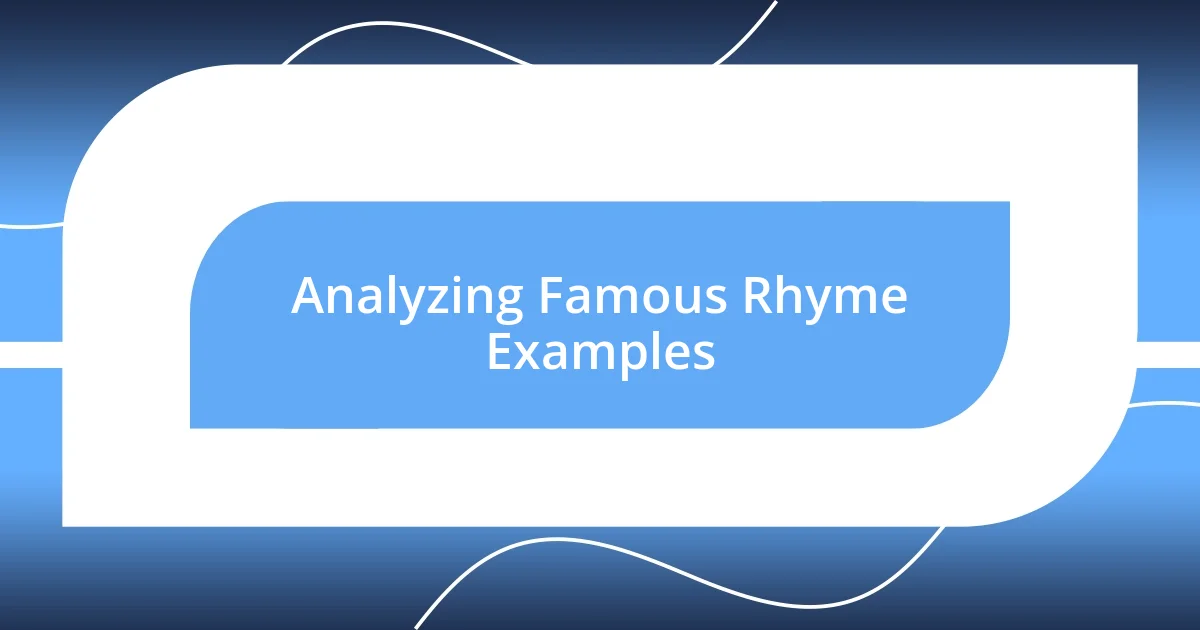
Analyzing Famous Rhyme Examples
As I dive into analyzing famous rhyme examples, I can’t help but think of Shakespeare’s sonnets. The ABABCDCDEFEFGG pattern captures a musicality that feels timeless. I remember studying “Sonnet 18” (“Shall I compare thee to a summer’s day?”) and being struck by how each rhyme effortlessly leads into the next, creating a mesmerizing flow. It’s a reminder of how rhyme can elevate the emotional stakes in poetry, don’t you think?
Looking at the content of a poem like Elizabeth Bishop’s “One Art,” I see the ABCB rhyme scheme at play with such finesse. The way Bishop weaves in that second and fourth line rhyme gives the poem a conversational quality that draws the reader in. I vividly recall the first time I encountered her reflections on loss; the rhyme felt catchy yet poignant, making me ponder the complexities of everyday experiences. Have you ever found yourself grasping deeper insights through the rhyme balance in a poem?
Then there are the playful touches in the works of Dr. Seuss. His ABAB scheme not only entertains but also delivers profound lessons hidden within whimsy. I find it fascinating how, in “The Cat in the Hat,” the rhyme scheme creates a sense of adventure and spontaneity. Every beat seems to urge kids (and adults alike) to join in on the fun, proving that rhyme can be not only a tool for structure but also a gateway to imagination. How has rhyme influenced your perspective on storytelling in poetry?
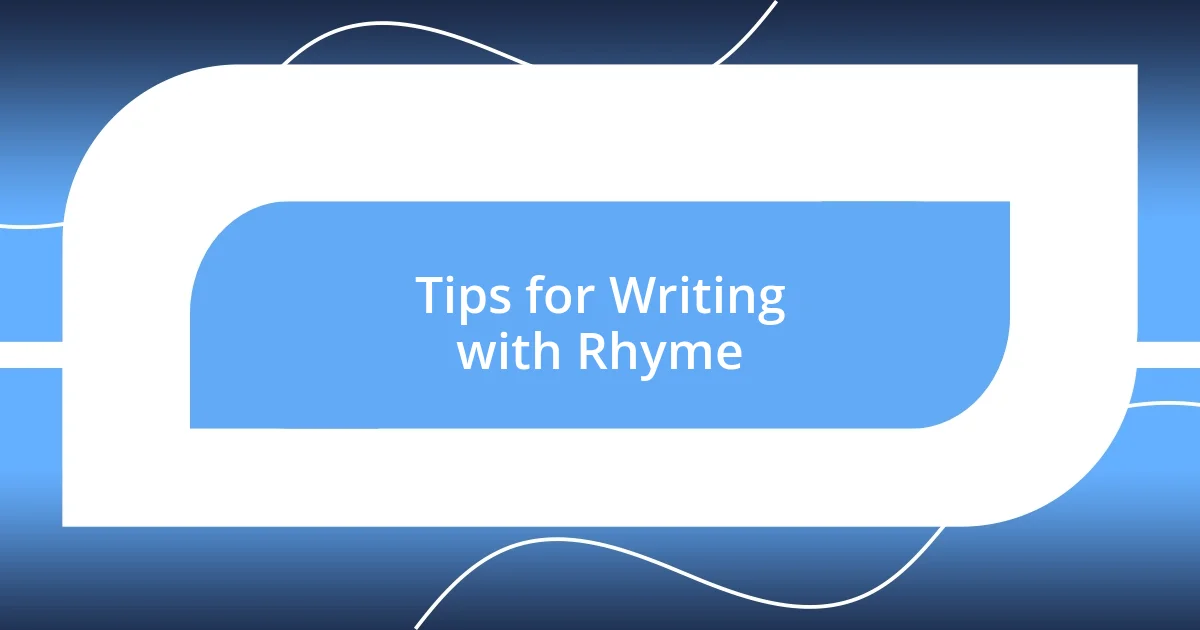
Tips for Writing with Rhyme
When I dive into writing with rhyme, I often find it helpful to start with a clear theme or emotion in mind. For instance, there was a time I wanted to express the joy of a summer day, and leaning into a simple AABB rhyme scheme made it feel like a cheerful song. Have you ever noticed how a focused theme guides your choice of words and rhythm?
Another tip I picked up is to play with slant rhymes—those near rhymes that don’t quite match but still resonate beautifully. I remember crafting a piece where I used “woven” and “given” in a conversation about connections, which added a layer of richness to the work. It made me wonder: could choosing slant rhymes introduce an unexpected twist that keeps readers engaged?
Lastly, I encourage experimenting with different forms to see what fits best. Once, I tried writing a poem in the traditional limerick style, and while it was challenging, the playful rhythm brought a joyous energy I hadn’t anticipated. Isn’t it exciting how breaking out of your comfort zone can lead to delightful surprises in your writing?






